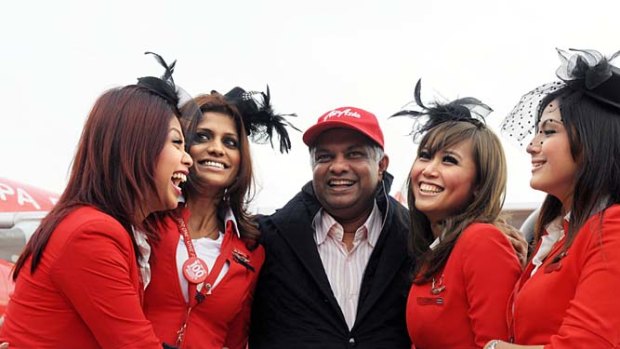
Plenty to smile about ... AirAsia chief executive Tony Fernandes (C) with flight attendants.Credit: AFP
AirAsia's low-cost model is reaping financial rewards, writes Clive Dorman.
He has become one of the region's most successful entrepreneurs but AirAsia founder Tony Fernandes admits he's "not really an airline person".
Inside the airline industry, which is used to measuring profits in small percentages, Fernandes caused a sensation last month when he showed it was possible for an airline to make money at the rate of the participants in Australia's banking oligopoly.
Most of the time, Malaysia-based AirAsia and its long-haul offshoot, AirAsia X, which flies to Australia, have the cheapest deals in town. They are as little as a few hundred dollars return to south-east Asia, pennies to fly inside Asia and sometimes less than $1000 return to Europe.
The numbers are spectacular: $500 million net profit on $1.83 billion turnover in 2010; in 2009-10 the Qantas group, including Jetstar, made $112 million on $13.8 billion in revenue.
But it is not a magic trick. About two-thirds of the AirAsia profit was "ancillary revenue" - fees for extras on mostly "costless inventory". That's technical jargon for services that cost little or nothing to produce.
We say if you want that service, you have to pay for it.
In Australia, Tiger Airways suffered backlash over its steep ancillary charges. AirAsia's ancillary charges are lower. "If you look at the bag charge by (Europe's) Ryanair or Tiger Airways (based on the Ryanair model), ours is very, very minimal," Fernandes says.
"But there is a business logic to it. Some of these airlines are just transferring sales from the ticket price to another area. But we're trying to do is give people a choice and make the cost equate to the revenue.
"If you take the bag charge, for instance, there is a cost for loading the bag onto the plane. There is a cost of the plane being heavier, which means more fuel is burnt. So we say if you want that service, you have to pay for it but we're not going to price you ridiculously ... out of the market.
"I'm on Facebook and Twitter and the only one (ancillary charge) that people seem to dislike is the convenience fee for using credit cards.
"Remember, we're adding things like insurance. So we're saying, if you travel, here are all the things that you might spend on - duty-free, hotels, food, insurance, etcetera, and we're saying rather than go and buy it from someone else, buy it all from us."
Fernandes concedes that without ancillary revenue, AirAsia is just another airline - back in the financial ruck with the full-service airline industry that has lost more money than it has ever made.
Unsurprisingly, full-service airlines - especially in the US - are adopting the model in the hope of financial salvation.
Susan Carey wrote in the Wall Street Journal last week about what she called "buy to fly". "Want a seat that reclines more? A pre-ordered champagne brunch in coach? Insurance against a blizzard that waylays a trip? Access to speedy security lines and early boarding? Soon you might be able to get them all - for a price," Carey writes.
For more from Clive Dorman, visit the Travellers' Check blog.
Sign up for the Traveller Deals newsletter
Get exclusive travel deals delivered straight to your inbox. Sign up now.